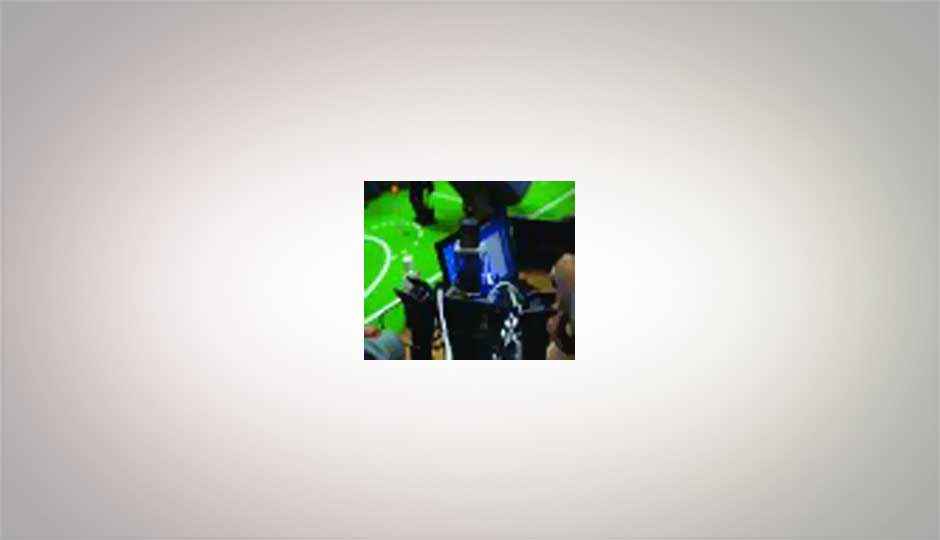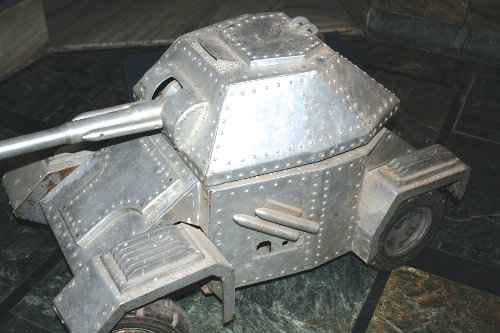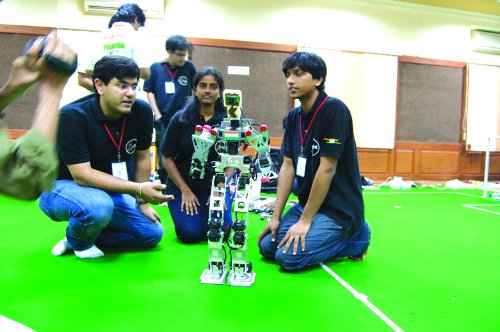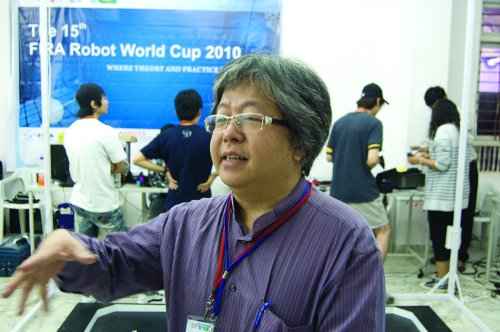A Soccer World Cup in India?

The Federation of International Robotsoccer Association (FIRA) organised the 15th Robot Soccer World Cup in India this year. We were excited at the opportunity to witness robots fighting it out at a game of soccer, in addition to other activities such as weightlifting, walking and climbing. Moreover, several of these robots were fully autonomous – humans don’t control their moves.
The cup
FIRA 2010 was filled with surprises and among them the most pleasant of all were the Indian participants. Two highlights are a 17-year old called Fateh, and AcYUT. Fateh is dear to us because he’s a part of the Digit community, and at just 17 is already building robots all by himself. He started playing with robots when he was still in school, and is proficient with C and microcontroller level programming, and also putting together the hardware.
Fateh credits Thinklabs at IIT Bombay for his foray into robotics. Not only did they help him hone up his skills in programming, they also got him familiar with the building blocks involved. Dr. Prahlad Vadakkepat, General Secretary, FIRA, believes youngsters such as Fateh, “are an example of the passion that the young population of Indian students display. India has immense talent and potential, however, many of these are unable to tap into their true potential for lack of resources or opportunities.”
FIRA 2010 also marked the foundation of FIRA India, and with it, the path for a national robotics event on a yearly basis. Hopefully, this would serve as the much needed fillip for universities and colleges to come together under a single umbrella to showcase their innovations and technical prowess in the field of robotics. Janesh Janardhanan, Secretriat and co-host, FIRA 2010 echoes these sentiments and is quite optimistic about the opportunity the national event would provide. According to him, this would provide a perfect blend of knowledge and opportunity in addition to an indispensable community that would harness the Indian contribution to the field of robotics. The need of the hour is increased awareness on the activities currently underway in Indian educational communities.
We also spoke to the team behind AcYut, the autonomous robot from BITS Pilani. AcYut won a special prize at the event for registering a World Record in weightlifting – 40 CDs (a standard for weights in robotics events). The team was quite forthcoming in explaining several terminologies associated with robotics. What began as a student-led project has moved across batches of students passing out of BITS Pilani. Newer students are inducted into the team as seniors pass out each year.
Next, we met up with students and professors from countries such as the UK, Singapore and Taiwan to get a feel of what the future holds. One of the people we met was Dr. Tzuu-Hseng S. Li, Dean, College of Electrical Engineering and Computer Science, National United University, Taiwan.
Dr. Li played referee for the semiautonomous and also autonomous Androsot robot soccer events. In the semi-autonomous event, each robot was coded using coloured paper on its “head”. An overhead camera tracks the robot and a server instructs it to move in the required direction. The robot is autonomous – it knows how to kick the ball, how to get up if it trips and falls, and how to chase the ball. The only information provided by the server is the location of the ball.
Given the rapid developments in the field of robotics, what can we expect in the future? According to Dr. Vadakkepat and FIRA President Dr. Kim Jong-Hwan, “we, as humans have not been able to adopt robots into our daily lives because we are emotional beings. Aibo, Sony’s robot pet for example, wasn’t adopted as popularly for the lack of association in a more realistic nature. You could tap and pet it, but you couldn’t get it to act naturally stupid!”
Classification of FIRA robots
The event was segregated into five categories as follows: Mirosot, HuroCup, AndroSot, RoboSot and SimuroSot as defined by FIRA.
Mirosots are rather small robotic bodies with dimensions restricted to 7.5×7.5×7.5cm. These compete in a game of soccer, played with an orange golf ball. The teams are controlled via one host computer per team. Similarly, HuroCup involves physical activities such as sprint, penalty kick, obstacle run, lifting and carrying, weight lifting, marathon, basketball and wall climbing.
AndroSots closely resemble humans to scale and proportion. These are two-legged robots that interpret the position of the ball, goal and members of the opposite team in a game of soccer. Also, these robots are fully autonomous.
RoboSots can be either fully or semi-autonomous. In the semi-autonomous mode, the on-board camera is used by the host computer to guide its movements.

.jpg)
.jpg)


